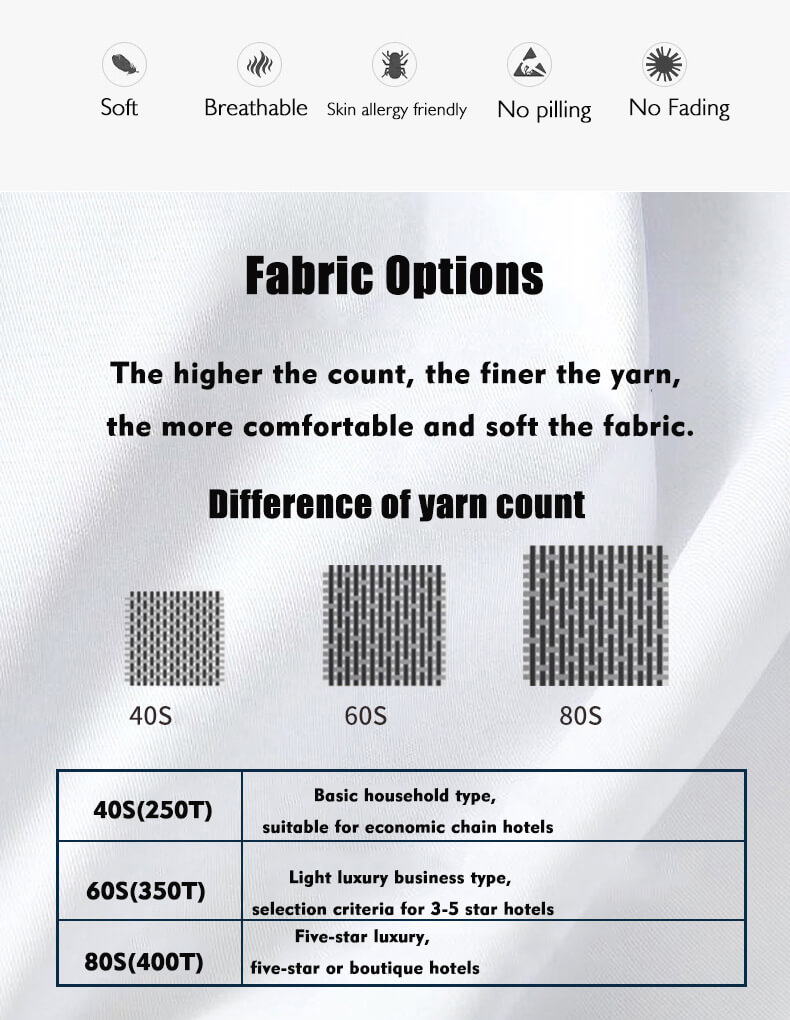Fabrics are generally made by spinning fibers into yarn and then weaving the yarn into fabric.
- Fibers:
- Definition: Fibers are natural or artificially synthesized slender substances with a length thousands of times greater than their diameter and a certain degree of flexibility. They are the primary materials needed for producing high-quality hotel linens.
- Classification: a. Natural fibers: Fibers directly obtained from nature, including plant fibers (e.g., cotton, linen) and animal fibers (e.g., wool, silk). b. Synthetic fibers: Fibers obtained through chemical processing and extrusion, such as acrylic, polyester, nylon, etc.
- Identifying fiber quality: The thickness and length of fibers are important factors determining the fabric’s texture. Coarser fibers result in a firm and rigid fabric with better compression resistance. Short fibers tend to create rougher fabrics that are prone to pilling. Finer fibers give fabrics a soft and thin texture. Longer fibers produce smoother yarns and are less likely to pill.
- Yarn:
- Yarn count: Yarn count is the basic unit of fabric composition, and the numerical value of yarn count is inversely proportional to the thickness of the yarn. A higher number indicates a finer yarn, which leads to lighter, thinner, and softer fabrics. A lower number indicates a coarser yarn, resulting in heavier, thicker, and rougher fabrics. For example, common yarn counts for bedding include 21s, 30s, 40s, and occasionally 80s.
- Yarn count identification: Yarn count is generally represented by the English “S” unit, which indicates the fineness of the yarn. The larger the number preceding the “S,” the finer the yarn, and the lighter, thinner, and softer the resulting fabric. Conversely, smaller numbers indicate coarser yarns, resulting in heavier, thicker, and rougher fabrics.
- Classification of hotel fabrics:
- Woven fabrics: Fabrics formed by the interweaving of yarns arranged vertically and horizontally on a loom. Examples include duvet covers, flat sheets, and tablecloth fabrics used in hotel linens.
- Non-woven fabrics: Fabrics created by bonding or stitching loose fibers together. The main methods used are bonding and puncturing. Examples include laundry bags and disposable slippers in hotel linens.
 Pure textile fabrics: Fabrics made from a single type of fiber, such as cotton fabrics, wool fabrics, silk fabrics, polyester fabrics, etc. Basic hotel linens like duvet covers, flat sheets, and pillowcases are usually made from pure cotton fabrics, also known as all-cotton fabrics.
Pure textile fabrics: Fabrics made from a single type of fiber, such as cotton fabrics, wool fabrics, silk fabrics, polyester fabrics, etc. Basic hotel linens like duvet covers, flat sheets, and pillowcases are usually made from pure cotton fabrics, also known as all-cotton fabrics.- Blended fabrics: Fabrics made from two or more different types of fibers blended together to form yarns. Some duvet covers, flat sheets, and pillowcases in hotel linens may be made from blended fabrics like polyester-cotton blends.
- Interwoven fabrics: Fabrics where two different fiber yarns are used in the two directions of the fabric. Many bed skirts and bed foot cushion fabrics in hotel linens are interwoven fabrics.
Choose Ulen, the Chinese brand, for selecting hotel linens! We are a one-stop supplier of hotel supplies!
The above information provides an encyclopedia of knowledge about hotel linens. In the next issue, we will continue to bring you more related knowledge about hotel linens.
Follow ulencn for professional insights into the hotel linen industry!